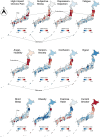Geographical variation in high-impact chronic pain and psychological associations at the regional level: a multilevel analysis of a large-scale internet-based cross-sectional survey
- PMID: 39726659
- PMCID: PMC11669661
- DOI: 10.3389/fpubh.2024.1482177
Geographical variation in high-impact chronic pain and psychological associations at the regional level: a multilevel analysis of a large-scale internet-based cross-sectional survey
Abstract
Background: A geographical analysis could be employed to uncover social risk factors and interventions linked to chronic pain. Nonetheless, geographical variation in chronic pain across different regions of Japan have not been well explored. This study aims to investigate geographical variation in high-impact chronic pain (HICP), defined as moderate to severe chronic pain, and examine the associated psychological factors at the prefecture level.
Methods: A cross-sectional Internet-based survey involving 52,353 participants was conducted to assess chronic pain conditions, stress levels, mood states, educational levels, living status, regions, sleep duration, and exercise habits. A geographical analysis evaluated the prevalence of HICP at the prefecture level, and a multilevel analysis explored the risk factors for HICP at both individual and prefecture levels.
Results: The geographical analysis revealed that Fukushima exhibited the highest HICP prevalence (23.2%; z-score = 2.11), Oita ranked second (23.0%; z-score = 2.00), and Okinawa showed the lowest prevalence (14.9%; z-score = -2.45). Geographical maps of Japan indicated that regional-level subjective stress, negative emotions, and short sleep were associated with higher HICP prevalence. In contrast, positive emotions, such as vigor, were associated with lower prevalence. Multilevel analysis revealed a significant improvement in model fit after incorporating psychological factors at the prefecture level (p < 0.001) and identified significant associations between high subjective stress and low vigor at the prefecture level with HICP prevalence (p < 0.001).
Conclusion: There are regional differences in HICP prevalence, and at the prefecture level, subjective stress and vigor are associated with HICP.
Keywords: geographical variation; high impact chronic pain; multilevel analysis; profile of mood states; subjective stress.
Copyright © 2024 Wakaizumi, Tanaka, Shinohara, Wu, Takaoka, Kawate, Oka and Matsudaira.
Conflict of interest statement
KM reports receiving grants and personal fees from AYUMI Pharmaceutical Corporation, Nippon Zoki Pharmaceutical Co., Ltd., Ono Pharmaceutical Co., Ltd, Shionogi Co., Ltd., Eli Lilly Japan, Astellas Pharma Inc., Toto Ltd., Eisai Co., Ltd., Teijin Pharma Limited, Japan Inc., and Hisamitsu Pharmaceutical Co., Inc.; personal fees from Pfizer Inc., Janssen Pharmaceutical K.K., Kaken Pharmaceutical Co., Ltd., Mochida Pharmaceutical Co., Ltd., and Daiichi Sankyo Company, Limited; grants from Sompo Holdings, Inc., MTG, NuVasive Japan, and Murata Manufacturing Co., Ltd.; grants from Okamura Corporation; and non-financial support from Trunk Solution Co., Ltd. outside the submitted work. HO received grants from Teijin Pharma Limited, grants from Pfizer Inc., grants from Fujifilm Medical Co., Ltd., grants and personal fees from AYUMI Pharmaceutical Corporation, Nippon Zoki Pharmaceutical Co., Ltd., Ono Pharmaceutical Co., Ltd., Sompo Holdings, Inc., NuVasive Japan, and grants from Eli Lilly Japan. The remaining authors declare that the research was conducted in the absence of any commercial or financial relationships that could be construed as a potential conflict of interest.
Figures


Similar articles
-
Chronic Pain and High Impact Chronic Pain in Children and Adolescents: A Cross-Sectional Study.J Pain. 2023 May;24(5):812-823. doi: 10.1016/j.jpain.2022.12.007. Epub 2022 Dec 25. J Pain. 2023. PMID: 36577459
-
Prevalence of chronic pain and high-impact chronic pain in Saudi Arabia.Saudi Med J. 2019 Dec;40(12):1256-1266. doi: 10.15537/smj.2019.12.24690. Saudi Med J. 2019. PMID: 31828278 Free PMC article.
-
The Relationship Between Financial Stressors, Chronic Pain, and High-Impact Chronic Pain: Findings From the 2019 National Health Interview Survey.Public Health Rep. 2023 May-Jun;138(3):438-446. doi: 10.1177/00333549221091786. Epub 2022 May 4. Public Health Rep. 2023. PMID: 35506496 Free PMC article.
-
Prevalence and Profile of High-Impact Chronic Pain in the United States.J Pain. 2019 Feb;20(2):146-160. doi: 10.1016/j.jpain.2018.07.006. Epub 2018 Aug 7. J Pain. 2019. PMID: 30096445 Free PMC article.
-
The measurement of "high-impact chronic pain": Limitations and alternative methods.Eur J Pain. 2025 Jan;29(1):e4710. doi: 10.1002/ejp.4710. Epub 2024 Aug 2. Eur J Pain. 2025. PMID: 39092627 Review.
Cited by
-
Application of Virtual Reality to Home-Visit Rehabilitation for Patients With Chronic Musculoskeletal Pain: A Single-Group Pre-post Comparison Study.Cureus. 2025 Mar 11;17(3):e80386. doi: 10.7759/cureus.80386. eCollection 2025 Mar. Cureus. 2025. PMID: 40213767 Free PMC article.
References
-
- Kennedy R, Abd-Elsayed A. The International Association for the Study of Pain (IASP) classification of chronic pain syndromes. Pain. (2019):1101–3. doi: 10.1007/978-3-319-99124-5_234 - DOI
-
- D’Souza RS, Her YF, Hussain N, Karri J, Schatman ME, Calodney AK, et al. . Evidence-based clinical practice guidelines on regenerative medicine treatment for chronic pain: a consensus report from a multispecialty working group. J Pain Res. (2024) 17:2951–3001. doi: 10.2147/JPR.S480559, PMID: - DOI - PMC - PubMed
MeSH terms
LinkOut - more resources
Full Text Sources
Medical

